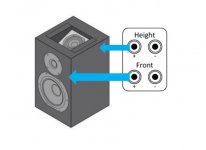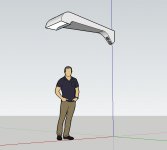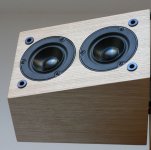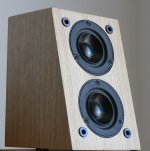DIY ATMOS surround speakers
Time has come for me to stop sitting on my hands and get something done.
For years I have been sitting on a sizable stock pile of high end drivers just waiting to be made into speakers.
I have only ever made one set of surround speakers before, but I noticed the big name brand speaker manufacturers often make the rear wall speakers as dipole speakers.
From what I can gather this is to defuse the sound. Which leads me into my question, I can understand them pointing the mid / woofers away from your head, but they also seem to use two tweeters as well, in the same configuration.
I was just wondering if this is really necessary. I have four RAAL 70-10D with amorphous core tweeters, I was planning to use for the four surround sound speakers but I could use them in only two speakers if it real made that big of a difference.
Thought and suggestions please.
Time has come for me to stop sitting on my hands and get something done.
For years I have been sitting on a sizable stock pile of high end drivers just waiting to be made into speakers.
I have only ever made one set of surround speakers before, but I noticed the big name brand speaker manufacturers often make the rear wall speakers as dipole speakers.
From what I can gather this is to defuse the sound. Which leads me into my question, I can understand them pointing the mid / woofers away from your head, but they also seem to use two tweeters as well, in the same configuration.
I was just wondering if this is really necessary. I have four RAAL 70-10D with amorphous core tweeters, I was planning to use for the four surround sound speakers but I could use them in only two speakers if it real made that big of a difference.
Thought and suggestions please.
Last edited:
My recent experience may help. When I originally built my theater 15 years ago I built dipoles for the surrounds as it was supposed to be required for thx certification at the time. I thought it must be better. I built them with 3" full range drivers. Thinking crazy volume and bass is not important for surrounds. They were always fine, but sometimes during a movie I would wonder if they were on or not. 3 years ago I built a new house and got a much larger theater. The surrounds were obviously not keeping up. I had a pair of dayton br1's handy (standard 2 way with single woofer and single tweeter, amazing little speaker btw) , so I put them in as surround sides, using the dipoles in the rear. Immediately the difference was unbelievable. A truck drove by in the scene and it rumbled past me as if it was there. Instead of "there might be a truck noise somewhere back there", it was "holy cow that truck is right there next to me". It's soooo much better. Also I was surprised how much the bass energy added to the effect. My auto setup in the receiver had set the xo on the br1's to 40hz. I had to switch it to 60 to increase power handling, but 40 was better. To sum it up, go conventional direct radiator and get as low as possible on the output. I am designing all new surrounds now with an 8" sub driver crossed to a line array of 1 or 2" full range drivers at about 800 Hz. Good luck, Craig
Hey Craig thanks for sharing your experiences. I know Klipsch have been doing the whole dipole thing forever, but as we all know in the last few years with things like Atmos coming onto the scene, it may challenge the past conventional thinking.
While I could spend another $1000+ buy two more tweeters. I wasn't sure if that thinking of dispersed sound blanket was still current thinking because if I understand the gist of Atmos, the idea is to have more directed sources, since they are making the movies that way to pinpoint the sound to a specific location in the room.
I think I am somewhat limited in what drivers I can use for the mids. The 70-10D AM have a recommended xover of LR4 at 2800 Hz, so I am thinking of matching them with the ScanSpeak 12MUs rather than the 18WUs (I have both here).
While I could spend another $1000+ buy two more tweeters. I wasn't sure if that thinking of dispersed sound blanket was still current thinking because if I understand the gist of Atmos, the idea is to have more directed sources, since they are making the movies that way to pinpoint the sound to a specific location in the room.
I think I am somewhat limited in what drivers I can use for the mids. The 70-10D AM have a recommended xover of LR4 at 2800 Hz, so I am thinking of matching them with the ScanSpeak 12MUs rather than the 18WUs (I have both here).
Reading through this document https://www.dolby.com/us/en/technol...tmos-home-theater-installation-guidelines.pdf
I just come across this...
Note: Dipole surround speakers are not recommended for use for Dolby Atmos playback.
Guess that answers my question.
I just come across this...
Note: Dipole surround speakers are not recommended for use for Dolby Atmos playback.
Guess that answers my question.
While on the subject of surround speakers has anyone done anything tricky on ATMOS height speakers?
It is often hard to build timbre matched speakers for the roof. One option is to build the height speakers into the rear speakers and bounce the sound off the roof. Although it isn't very point specific.
Has anyone experimented with something like a transmission line porting at the roof?
It is often hard to build timbre matched speakers for the roof. One option is to build the height speakers into the rear speakers and bounce the sound off the roof. Although it isn't very point specific.
Has anyone experimented with something like a transmission line porting at the roof?
Attachments
Fwiw, I did put atmos in the new house. Just did 8" dayton ceiling speakers. I believe that they made surround more enveloping if that's a word. Nothing earth shattering though. Maybe with the extra speakers in the ceiling helped supplement the more directional surrounds to still give enough "hall reverb" effect if you know what I mean.
I was thinking rather than sticking the speakers in the ceiling itself for dust and dirt to fall into the back of the drivers, I was thinking perhaps I could make something like this where the driver is not hanging directly down causing it to sag, but can still get the sound from the right place.
Attachments
That looks very interesting. Very difficult build though, and being a horn it will load different frequencies differently if not carefully designed. That size exit on the picture would only load down to maybe 200hz. It would have to be pretty huge to get down to 60hz, and high frequencies don't do so well in a folded horn, that one looks like a back horn, so all the highs would be coming from the corner, not out of the horn above you. Some large challenges.
I went in the attic and siliconed down an upside down cheap plastic flower pot as an enclosure. Then put the insulation back. Wouldn't work with no attic above. Parts express I believe sells a hair net like thing that keeps dust out of ceiling speakers.
I went in the attic and siliconed down an upside down cheap plastic flower pot as an enclosure. Then put the insulation back. Wouldn't work with no attic above. Parts express I believe sells a hair net like thing that keeps dust out of ceiling speakers.
The picture is for illustration only, just to show a concept. Since I have free reign to do whatever I want in the home theatre room, I am not constrained to fitting in ceiling speaker to meet a WAF.
So if I can design something that outperforms a typical in ceiling speaker I am free to do so.
So if I can design something that outperforms a typical in ceiling speaker I am free to do so.
While on the subject of surround speakers has anyone done anything tricky on ATMOS height speakers?
It is often hard to build timbre matched speakers for the roof. One option is to build the height speakers into the rear speakers and bounce the sound off the roof. Although it isn't very point specific.
The Atmos height speakers are added to the top of the front speakers so they bounce off the ceiling towards the listener. Adding to the rear speaker would not be effective IMO. The receiver's speaker setup does the equalisation so the reflected sound is effective plus there are option settings on their location.
I've built a Presence / Atmos speaker that sits on top of my music Stereo speakers that are further apart than my HT front speakers. They are designed so they can sit up for Presence (how they are used) or on their back for Atmos (never tried) with a 15° baffle angle. At the moment tweeters are being added as these FR drivers are lacking in the top 2 octaves. I've tried them as MM (series) as well as 1.5 way (series) and on both, the top end sounds the same.
There's only a small amount of information that comes through these speakers but it does add to the effects and seems to compliment the rears. I wouldn't worry too much about matching the timber of the LRC as I think you would be hard pressed to notice the difference during a movie. All the Atmos speakers I've seen do not do low bass and they seem to go down to around 100Hz at best.
That said, for Atmos if you can fit (4?) ceiling speakers then that the best option from what I have read. For us that can't, reflected sound from the front has to be the only way.
Attachments
Last edited:
Dipole surrounds are a throwback to the Pro Logic era. I did a fair bit of testing dipole, bipole and monopole some time back for surrounds, and have been firmly monopole since then. I thought the other configs, for want of a better word, sucked.
As for timbre matching for surrounds, it's very overrated. I have Unity's in the front, and 3 way 15" + 8" coax surrounds and it doesn't bother me at all that they're different. The previous were 15/10/1 and were only replaced because they didn't seem to gel correctly at the side as hey were quite close due to narrow room.
I'm yet to be convinced that UHD discs are going to take off yet so am keeping Atmos on the backburner but have 4 more 8" coaxes for them, just in case.
As for timbre matching for surrounds, it's very overrated. I have Unity's in the front, and 3 way 15" + 8" coax surrounds and it doesn't bother me at all that they're different. The previous were 15/10/1 and were only replaced because they didn't seem to gel correctly at the side as hey were quite close due to narrow room.
I'm yet to be convinced that UHD discs are going to take off yet so am keeping Atmos on the backburner but have 4 more 8" coaxes for them, just in case.
- Status
- Not open for further replies.
- Home
- Loudspeakers
- Multi-Way
- DIY surround speakers



